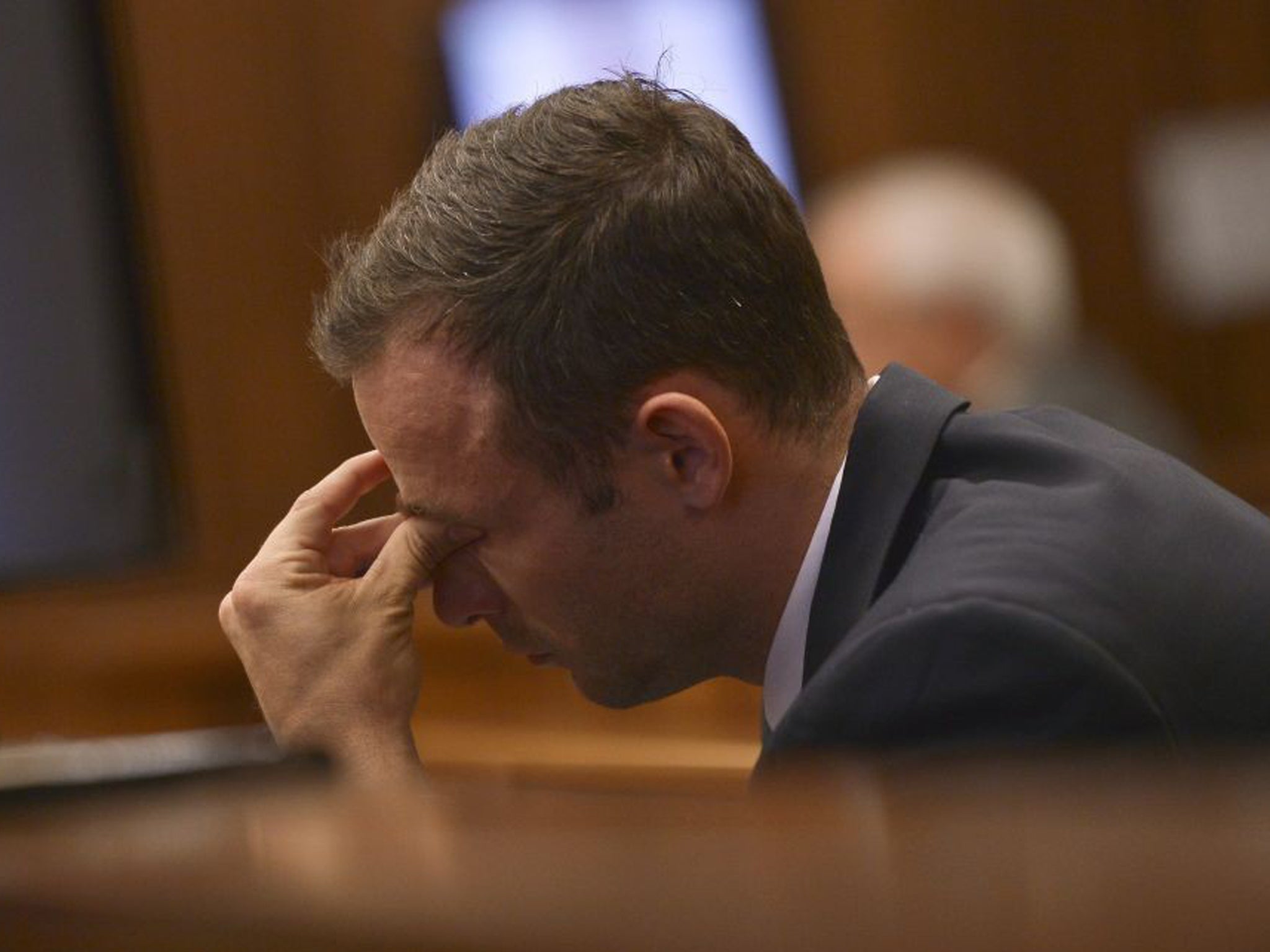Oscar Pistorius trial: Paralympian sick again after photographs of Reeva Steenkamp's body are shown in court
Photographs of blood-stained crime scene shown in court as murder trial continues

Your support helps us to tell the story
From reproductive rights to climate change to Big Tech, The Independent is on the ground when the story is developing. Whether it's investigating the financials of Elon Musk's pro-Trump PAC or producing our latest documentary, 'The A Word', which shines a light on the American women fighting for reproductive rights, we know how important it is to parse out the facts from the messaging.
At such a critical moment in US history, we need reporters on the ground. Your donation allows us to keep sending journalists to speak to both sides of the story.
The Independent is trusted by Americans across the entire political spectrum. And unlike many other quality news outlets, we choose not to lock Americans out of our reporting and analysis with paywalls. We believe quality journalism should be available to everyone, paid for by those who can afford it.
Your support makes all the difference.Oscar Pistorius threw up in court again after a picture of girlfriend Reeva Steenkamp's blood-covered body was accidentally shown at his murder trial in Pretoria.
Ms Steenkamp's body was shown for just a fraction of a second, prompting loud winces in court as screens in court rapidly scrolled from a picture of Pistorius' bathroom to another of the athlete's blood-stained prosthetic legs.
A series of photographs showing cartridge cases on the floor, the window open, a panel of the door smashed through, and large, deep puddles of blood, were presented in public for the first time.
One of the screens, just a few feet in front of Pistorius, was turned off shortly after he was sick so he would not have to see any more graphic images.
Colonel Schoombie Van Rensburg, one of the two officers to first arrive at the scene, told the court he saw Ms Steenkamp's body covered in towels and plastic bags used by Pistorius in a bid to stop the bleeding.

Pistorius was helped by the daughter of Silver Woods estate manager Johan Stander, Carice. She told police Pistorius had called them in need of help after Ms Steenkamp was shot.
Col Van Rensburg said a female paramedic approached and told him the woman had been declared dead on their arrival.
He found the athlete in the kitchen and asked him what had happened, but Pistorius appeared to be in shock and did not respond.
"We then followed the trail of blood up the stairs," he told Pretoria's High Court.
The photographs showed spots of blood on the floor and the walls of Pistorius’s stairs and hallway. Other pictures showed deep pools of blood on the bathroom floor, and large parts of the demolished door.
Col Van Rensburg found the gun lying on top of a grey towel. He said the hammer was pulled back and ready to fire.
The bathroom key was inserted in to the outside of the door. This appears to contradict Pistorius’ bail statement where he claimed he found the key on the floor after smashing down the door with a cricket bat.
Earlier, Pistorius's defence counsel Barry Roux challenged forensic analyst Lt Col Johannes Vermuelen, who claimed the athlete was standing on his stumps when he struck the door with a cricket bat in a bid to reach Ms Steenkamp.
This contradicts the version of events given by Pistorius, who claimed he was wearing his prosthetic legs at the time. Mr Roux showed the court photographs of the blood-stained prosthetic legs, which he claims were used by Pistorius to kick down the door.
Mr Roux questioned the methods used by police and suggested the crime scene had been contaminated during the investigation. He said that Pistorius's watch collection had disappeared and pieces of the door had gone missing.
The lawyer also noted that Lt Col Vermeulen had not read Pistorius' version of events on the night Ms Steenkamp was shot until after he had completed his forensic study of the door, and was therefore relying on the prosecution's version of what happened.
State prosecutor Gerrie Nel asked him it was possible Pistorius could have kicked the door before shooting through it, and before hitting it with a cricket bat, perhaps "to scare someone".
Lt Col Vermuelen conceded there is no set timeline for the gunshots, Pistorius' kicking and the cricket bat strikes.
The door has been viewed as crucial evidence in the case, and was removed from the athlete's home in the hours after he shot Ms Steenkamp. The marks on the door could determine the angle and height from which Pistorius fired.
Last week, Pistorius pleaded not guilty to murdering Ms Steenkamp, claiming he shot her in a case of mistaken identity thinking she was an intruder.
Prosecutors argue he intentionally shot and killed his girlfriend following a domestic dispute. If convicted of murder he will almost certainly receive a life sentence, with a minimum term of 25 years.
The case continues.